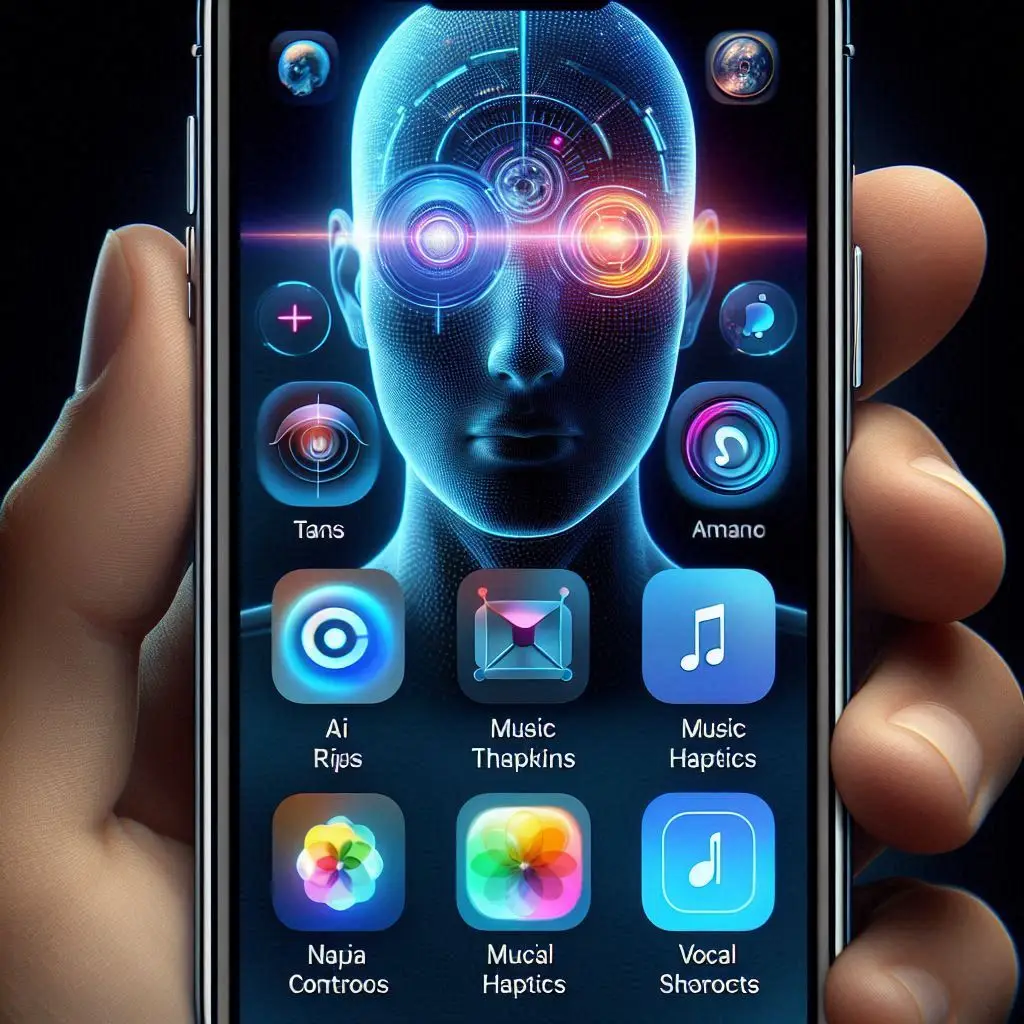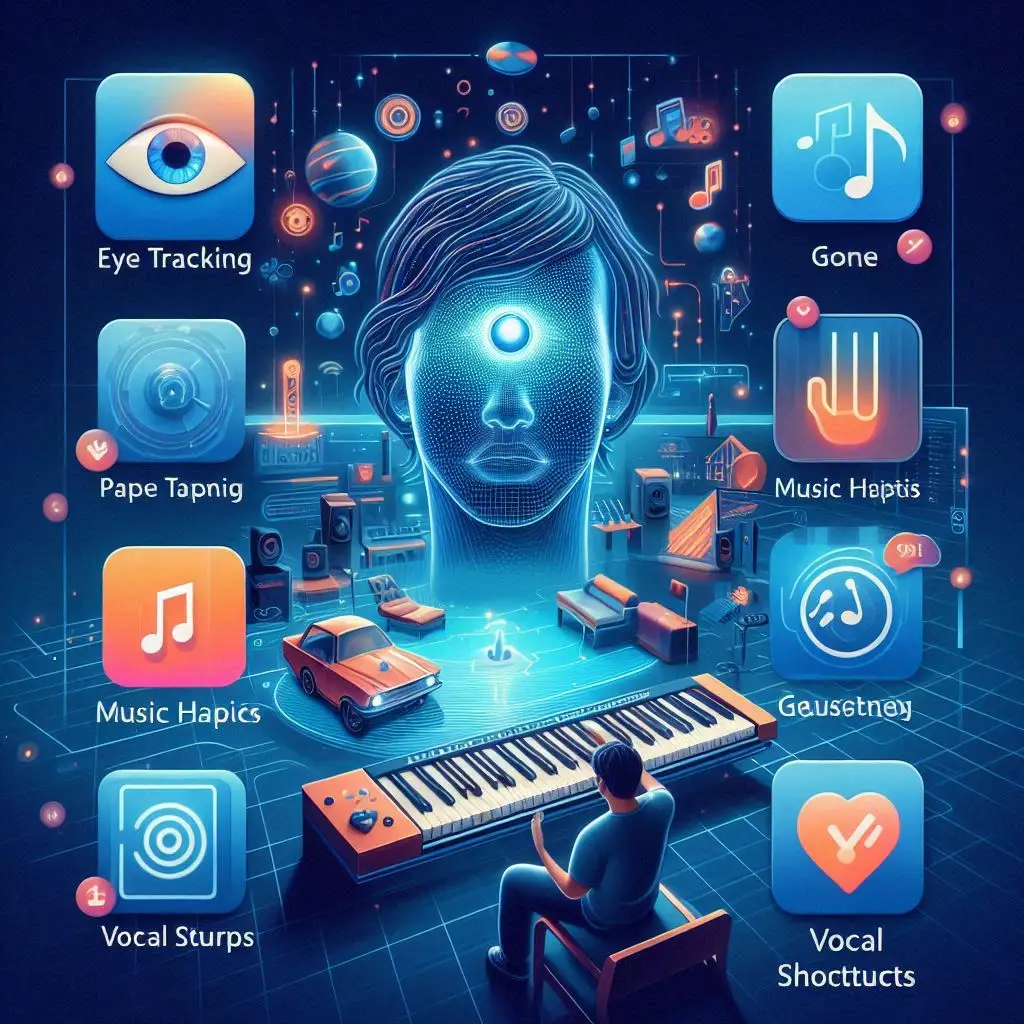Introduction
Introduction to iOS 18 and its New Accessibility Features
Apple has once again demonstrated its commitment to innovation and inclusivity with the upcoming release of iOS 18. Among the exciting new features announced, AI-powered Eye Tracking, Music Haptics, and Vocal Shortcuts stand out as game changers in the realm of accessibility. These advancements are not just technological novelties but pivotal tools that could transform the lives of users with physical disabilities.
Overview of the Significance
The introduction of these features underscores Apple’s dedication to making technology accessible to all. By leveraging AI to enhance user interaction with their devices, Apple is setting a new standard in the industry, ensuring that even those with severe physical limitations can enjoy the full spectrum of capabilities offered by modern technology.
Eye Tracking
What is Eye Tracking?
Eye tracking technology allows devices to interpret and respond to the movement of a user’s eyes. This involves sophisticated algorithms that can accurately detect where the user is looking on the screen, translating these movements into actions.
Apple's implementation of eye tracking in iOS 18 is designed to be seamless and user-friendly. By using the front-facing camera and advanced AI, iPads and iPhones can track eye movements without requiring additional hardware.
Technical Specifications
The eye-tracking system in iOS 18 relies on machine learning models that analyze real-time data from the device’s camera. These models are trained to recognize eye positions and movements, allowing precise control over the device’s interface.
Applications and Use Cases
Eye tracking can be used for various applications, from navigating the home screen to opening apps, selecting items, and typing messages. This feature is particularly beneficial for users with motor disabilities, offering them a new level of independence.
Benefits for Users with Disabilities
For users with physical disabilities, eye tracking provides an invaluable tool for interaction. It removes the physical barriers that prevent these users from fully utilizing their devices, enabling them to communicate and interact with technology more naturally.
Music Haptics
Introduction to Music Haptics
Music Haptics is another innovative feature in iOS 18 that enhances the auditory experience by adding a tactile dimension. This feature leverages the Taptic Engine in iPhones to translate music into haptic feedback.
How It Works
Music Haptics works by analyzing the audio output and generating corresponding vibrations that sync with the rhythm and beats of the music. These vibrations are felt through the device, providing an immersive experience.
Enhancing the Music Experience
By adding a tactile element to music, users can feel the rhythm and intensity of their favorite songs. This feature can be particularly beneficial for individuals who are hard of hearing, as it offers an alternative way to experience music.
Potential Benefits for Accessibility
Music Haptics can greatly enhance the accessibility of music for users with hearing impairments, allowing them to engage with audio content in a novel and enjoyable way.
Broader Implications for Sensory Feedback
Beyond music, this technology could be applied to other areas, such as video playback or gaming, where haptic feedback can enhance the user experience by providing sensory cues.

Vocal Shortcuts
Introduction to Vocal Shortcuts
Vocal Shortcuts in iOS 18 allow users to create custom voice commands that Siri can recognize to perform specific tasks. This feature simplifies interaction with the device, making it more intuitive and efficient.
How to Set Up Vocal Shortcuts
Setting up Vocal Shortcuts is straightforward. Users can go into the Settings app, navigate to the Siri & Search section, and create new shortcuts by recording custom phrases and linking them to desired actions.
Examples of Use Cases
Examples of Vocal Shortcuts include saying "Goodnight" to turn off the lights, "Workout time" to launch a fitness app, or "Play my favorites" to start a music playlist. These shortcuts streamline daily routines and enhance productivity.
Accessibility Benefits
For users with mobility impairments, Vocal Shortcuts offer a hands-free way to control their devices and execute complex commands quickly. This feature reduces the need for manual interaction and enhances the overall user experience.
AI and Accessibility
AI is at the heart of these new features in iOS 18, driving the sophisticated algorithms that enable eye tracking, music haptics, and vocal shortcuts. AI enhances the ability of devices to understand and respond to user needs, making technology more accessible.
Examples of AI in Accessibility
In addition to the new features, AI is already being used in other accessibility tools like voice-to-text, facial recognition for unlocking devices, and predictive text input. These AI-driven features help users with various disabilities interact more easily with their devices.
AI-Powered Personalization
AI can personalize the user experience by learning individual preferences and adapting functionalities accordingly. For example, eye-tracking sensitivity can be adjusted based on user behavior, making the technology more responsive to individual needs.
Future Potential of AI in Accessibility
The potential for AI in accessibility is vast. Future developments could include even more sophisticated interaction methods, such as gesture recognition or advanced speech synthesis, further breaking down barriers for users with disabilities.
Apple’s Commitment to Accessibility
Apple’s History with Accessibility
Apple has a long-standing commitment to accessibility, consistently introducing features that make its devices usable for all. From VoiceOver and Zoom to AssistiveTouch, Apple’s accessibility tools have set a high standard in the industry.
Impact of iOS 18 on Accessibility
The new features in iOS 18 continue this tradition, pushing the boundaries of what’s possible with technology to support users with disabilities. These advancements are a testament to Apple’s ongoing dedication to inclusivity.
Stories from users who have benefited from Apple’s accessibility features highlight the profound impact these tools can have. For many, these technologies are not just conveniences but essential components of their daily lives.
Partnerships and Collaborations
Apple collaborates with various organizations and experts to ensure its accessibility features meet the needs of all users. These partnerships help Apple stay at the forefront of accessibility innovation.
Future Directions for Apple Accessibility
Looking ahead, Apple’s focus on accessibility is likely to continue, with further advancements in AI and other technologies poised to enhance the inclusivity of its devices.

Technical Deep Dive
Machine Learning and Eye Tracking
The machine learning models used for eye tracking in iOS 18 are trained on large datasets to accurately interpret eye movements. These models continuously improve through user interaction, becoming more precise over time.
Haptic Feedback Technology
The Taptic Engine, used for Music Haptics, is a sophisticated piece of technology that generates precise vibrations. Its integration with audio output allows for real-time synchronization, creating an immersive sensory experience.
Natural Language Processing in Vocal Shortcuts
Vocal Shortcuts leverage advances in natural language processing (NLP) to understand and interpret custom phrases. This allows Siri to accurately execute tasks based on user-defined commands.
Integration with Existing Accessibility Features
The new features in iOS 18 are designed to integrate seamlessly with existing accessibility tools. For example, eye tracking can be used in conjunction with VoiceOver to provide a comprehensive interaction solution for visually impaired users.
Security and Privacy Considerations
Apple places a strong emphasis on user privacy and security. All AI-driven features, including eye tracking and vocal shortcuts, are designed with robust security measures to protect user data and ensure privacy.
User Experience
Ease of Use and Setup
Apple’s focus on user experience ensures that the new accessibility features are easy to set up and use. Clear instructions and intuitive interfaces make these tools accessible to all users.
Customization Options
Users can customize the sensitivity and behavior of eye tracking, the intensity of haptic feedback, and the specific commands for vocal shortcuts. This flexibility allows for a personalized user experience.
Feedback and Iteration
Apple actively seeks feedback from users to continuously improve its accessibility features. This iterative process helps refine the tools and ensure they meet the evolving needs of users.
Compatibility with Third-Party Apps
Many third-party apps are expected to integrate with the new accessibility features in iOS 18. This compatibility extends the benefits of these tools beyond Apple’s native apps, creating a more inclusive app ecosystem.
Challenges and Considerations
Technical Challenges in Eye Tracking
Developing accurate and reliable eye-tracking technology presents several challenges, including variations in lighting conditions, facial features, and eye movement patterns. Apple’s advanced AI algorithms address these challenges to deliver a robust solution.
Adapting to Different User Needs
Users have diverse needs and preferences, requiring flexibility in the design of accessibility features. Apple’s customization options and continuous improvement efforts help address these varying requirements.
Ensuring Reliability and Accuracy
For accessibility features to be truly effective, they must be reliable and accurate. Apple’s rigorous testing and quality assurance processes ensure that the new tools in iOS 18 meet these high standards.
Balancing Innovation with Usability
While pushing the boundaries of technology, Apple also focuses on usability. The new features are designed to be intuitive and user-friendly, ensuring they can be easily adopted by all users.
Conclusion
IOS 18 introduces groundbreaking accessibility features, including AI-powered eye tracking, music haptics, and vocal shortcuts. These tools leverage advanced AI to provide new ways for users, especially those with disabilities, to interact withtheir devices.
The Impact of iOS 18 on Accessibility
The enhancements in iOS 18 have the potential to significantly improve the quality of life for users with disabilities, offering them greater independence and a more inclusive technology experience.
Apple’s Role in Leading Accessibility Innovation
Apple’s continued focus on accessibility sets an example for the tech industry. By integrating AI and other advanced technologies into its accessibility features, Apple is paving the way for a more inclusive future.
Looking Ahead: Future Possibilities
As AI technology continues to evolve, so too will its applications in accessibility. The advancements in iOS 18 are just the beginning, with future updates likely to bring even more innovative solutions.
Call to Action for the Tech Community
Apple’s commitment to accessibility serves as a call to action for other tech companies to prioritize inclusivity in their product designs. Collaborative efforts across the industry can help ensure that technology is accessible to all.
Final Thoughts on Technology and Inclusivity
Technology has the power to break down barriers and create opportunities for everyone, regardless of physical abilities. Apple’s iOS 18 is a testament to this potential, showcasing how thoughtful design and advanced technology can make a meaningful difference in people’s lives.
Reflections from Accessibility Advocates
Feedback from accessibility advocates highlights the importance of these new features. Their insights and experiences underscore the transformative impact that accessible technology can have.
The User Community’s Response
Early responses from the user community indicate excitement and optimism about the new features. Users are eager to explore the enhanced capabilities and see how they can improve their daily lives.
Apple’s Vision for the Future
Apple’s vision for the future includes continuous innovation in accessibility, driven by user feedback and technological advancements. The company remains committed to making its devices more inclusive with each new release.
Embracing Change and Innovation
Embracing change and innovation is key to advancing accessibility. Apple’s approach to integrating AI into its accessibility features exemplifies this mindset, pushing the boundaries of what’s possible.
Collaborative Efforts in Accessibility
Collaboration with users, experts, and organizations is crucial to the success of accessibility initiatives. Apple’s partnerships and engagement with the community ensure that its solutions are both effective and relevant.
A Brighter, More Inclusive Future
The advancements in iOS 18 signal a brighter, more inclusive future for technology. By prioritizing accessibility, Apple is helping to create a world where everyone can benefit from the power of technology.









Add a Comment: